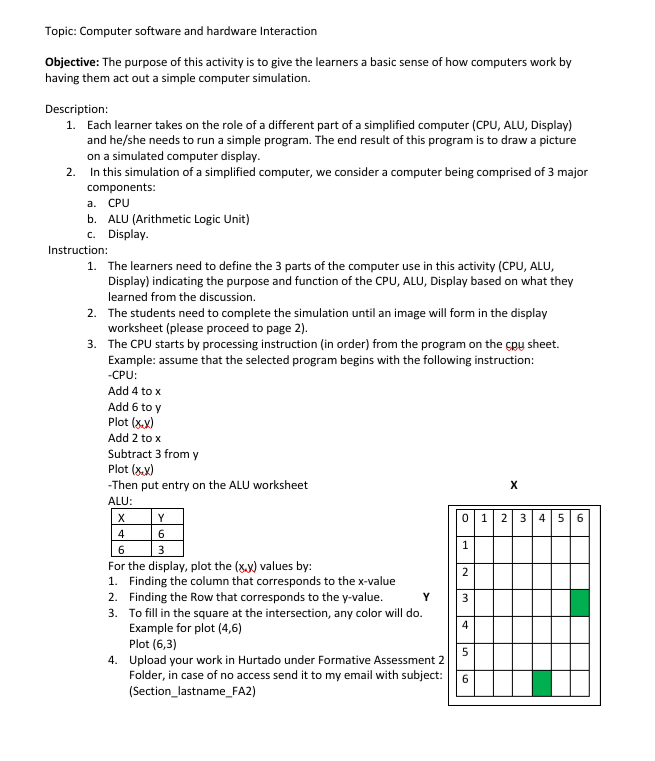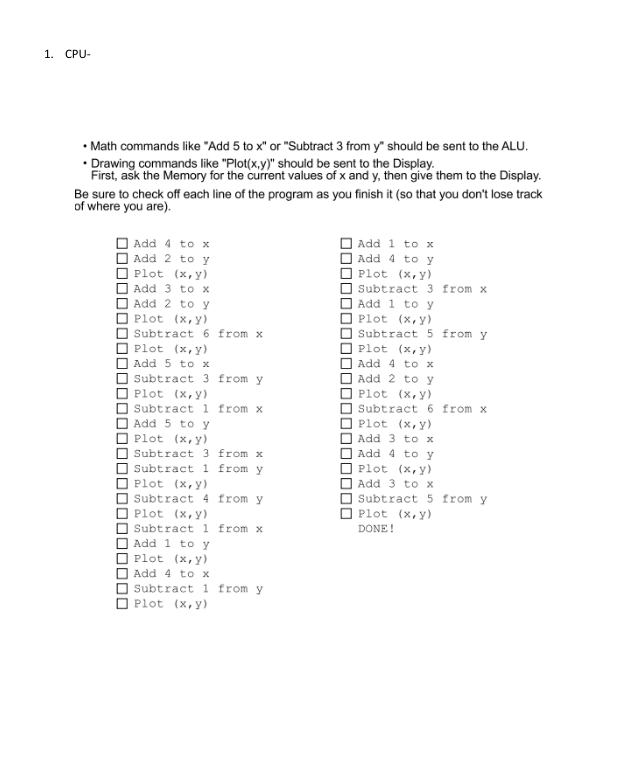The learners need to define the 3 parts of the computer use in this activity (CPU, ALU, Display) indicating the purpose and function of the CPU, ALU, Display based on what they learned from the discussion.
The learners need to define the 3 parts of the computer use in this activity (CPU, ALU, Display) indicating the purpose and function of the CPU, ALU, Display based on what they learned from the discussion.
Computer Networking: A Top-Down Approach (7th Edition)
7th Edition
ISBN:9780133594140
Author:James Kurose, Keith Ross
Publisher:James Kurose, Keith Ross
Chapter1: Computer Networks And The Internet
Section: Chapter Questions
Problem R1RQ: What is the difference between a host and an end system? List several different types of end...
Related questions
Question

Transcribed Image Text:Topic: Computer software and hardware Interaction
Objective: The purpose of this activity is to give the learners a basic sense of how computers work by
having them act out a simple computer simulation.
Description:
1. Each learner takes on the role of a different part of a simplified computer (CPU, ALU, Display)
and he/she needs to run a simple program. The end result of this program is to draw a picture
on a simulated computer display.
2. In this simulation of a simplified computer, we consider a computer being comprised of 3 major
components:
а. СPU
b. ALU (Arithmetic Logic Unit)
c. Display.
Instruction:
1. The learners need to define the 3 parts of the computer use in this activity (CPU, ALU,
Display) indicating the purpose and function of the CPU, ALU, Display based on what they
learned from the discussion.
2. The students need to complete the simulation until an image will form in the display
worksheet (please proceed to page 2).
3. The CPU starts by processing instruction (in order) from the program on the cpu sheet.
Example: assume that the selected program begins with the following instruction:
-CPU:
Add 4 to x
Add 6 to y
Plot (x.x)
Add 2 to x
Subtract 3 from y
Plot (x.x)
-Then put entry on the ALU worksheet
ALU:
X
Y
0 123 4 56
4
6
1
6
For the display, plot the (x.y) values by:
1. Finding the column that corresponds to the x-value
2. Finding the Row that corresponds to the y-value.
3. To fill in the square at the intersection, any color will do.
Example for plot (4,6)
2
Plot (6,3)
4. Upload your work in Hurtado under Formative Assessment 2
5
Folder, in case of no access send it to my email with subject:
(Section_lastname_FA2)
3.
4.
9.

Transcribed Image Text:1. CPU-
• Math commands like "Add 5 to x" or "Subtract 3 from y" should be sent to the ALU.
• Drawing commands like "Plot(x,y)" should be sent to the Display.
First, ask the Memory for the current values of x and y, then give them to the Display.
Be sure to check off each line of the program as you finish it (so that you don't lose track
of where you are).
Add 4 to x
Add 2 toy
Plot (x, y)
Add 1 to x
Add 4 to y
Plot (x, y)
Add 3 to x
Add 2 to y
O Plot (x, y)
O Subtract 6 from x
Plot (x,y)
Subtract 3 from x
Add 1 to y
Plot (x,y)
Subtract 5 from y
Plot (x, y)
Add 4 to x
Add 2 to y
Plot (x, y)
Add 5 to x
Subtract 3 from y
Plot (x,y)
O Subtract 1 from x
O Add 5 to y
Plot (x, y)
Subtract 6 from x
Plot (x, y)
Add 3 to x
Subtract 3 from x
Add 4 to y
Subtract 1 from y
O Plot (x,y)
O subtract 4 from y
O Plot (x, y)
Plot (x, y)
Add 3 to x
Subtract 5 from y
Plot (x, y)
Subtract 1 from x
DONE !
Add 1 to y
Plot (x, y)
Add 4 to x
O Subtract 1 from y
O Plot (x,y)
Expert Solution
This question has been solved!
Explore an expertly crafted, step-by-step solution for a thorough understanding of key concepts.
Step by step
Solved in 3 steps

Recommended textbooks for you

Computer Networking: A Top-Down Approach (7th Edi…
Computer Engineering
ISBN:
9780133594140
Author:
James Kurose, Keith Ross
Publisher:
PEARSON

Computer Organization and Design MIPS Edition, Fi…
Computer Engineering
ISBN:
9780124077263
Author:
David A. Patterson, John L. Hennessy
Publisher:
Elsevier Science

Network+ Guide to Networks (MindTap Course List)
Computer Engineering
ISBN:
9781337569330
Author:
Jill West, Tamara Dean, Jean Andrews
Publisher:
Cengage Learning

Computer Networking: A Top-Down Approach (7th Edi…
Computer Engineering
ISBN:
9780133594140
Author:
James Kurose, Keith Ross
Publisher:
PEARSON

Computer Organization and Design MIPS Edition, Fi…
Computer Engineering
ISBN:
9780124077263
Author:
David A. Patterson, John L. Hennessy
Publisher:
Elsevier Science

Network+ Guide to Networks (MindTap Course List)
Computer Engineering
ISBN:
9781337569330
Author:
Jill West, Tamara Dean, Jean Andrews
Publisher:
Cengage Learning

Concepts of Database Management
Computer Engineering
ISBN:
9781337093422
Author:
Joy L. Starks, Philip J. Pratt, Mary Z. Last
Publisher:
Cengage Learning

Prelude to Programming
Computer Engineering
ISBN:
9780133750423
Author:
VENIT, Stewart
Publisher:
Pearson Education

Sc Business Data Communications and Networking, T…
Computer Engineering
ISBN:
9781119368830
Author:
FITZGERALD
Publisher:
WILEY